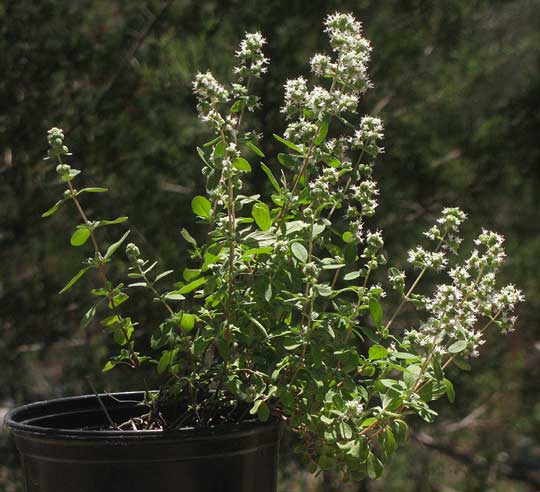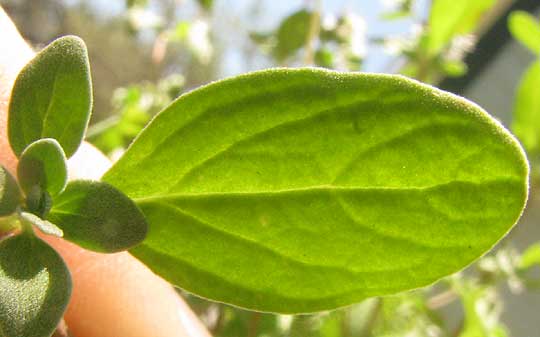Excerpts from Jim Conrad's
Naturalist Newsletter

from the May 18, 2014 Newsletter issued from the Frio Canyon Nature Education Center in the valley of the Dry Frio River in northern Uvalde County, southwestern Texas, on the southern border of the Edwards Plateau; elevation ~1750m (~5750 ft); N29.62°, W99.86°; USA
MARJORAM FLOWERING
Last winter my friend Deborah gave me a potted, woody-based sprout of Marjoram she'd cut from one of her own shrubby plants. I was tickled to have it because I've always heard of Marjoram and I've seen it sold as an herbal spice but I had no experience with it. I didn't know what to expect of the flowers, other than that they'd follow the rules of the Mint Family to which Marjoram belongs, which meant that the corollas probably would display bilateral symmetry like a snapdragon flower instead of radial like an iris. Also it'd bear four or two stamens instead of the more usual five, and the ovary would be deeply four-lobed. Below, you can see my potted plant happily soaking up the sun:

As expected of the Mint Family, the plant bears two leaves per node -- they're opposite -- and the stems are square in cross section. The flowers with their four stamens are not spectacular, but they're clustered in a novel way, as shown at the top of this page.
In that photo, the fuzzy, green, more or less spherical object in the picture's center, composed of several hairy, disklike objects, is a tightly grouped cluster of flattish calyxes, a calyx being the usually green, cuplike structure beneath a corolla. These flat calyxes are strange, because usually they're bowl-like, and their systematic arrangement in such a cluster is unusual. The calyxes in their cluster take turns flowering, so a cluster might contain calyxes from which corollas have not yet emerged, some from which corollas are emerging now, and some from which corollas already have emerged, so that now the deeply lobed ovaries are maturing into nutlets inside the calyx. Once you pay attention to this very novel construction, you'll never confuse Marjoram with another flowering plant.
Also the above picture shows that Marjoram's white corollas are not as strikingly bilaterally symmetrical as many in the Mint Family. Still, if you look closely at the blossom at the picture's lower, right corner, you'll see that two petals are considerably wider than the other two, so the corolla really is bilaterally symmetrical. You can see the pretty but ordinary looking Marjoram leaf below:

Marjoram is ORIGANUM MAJORANA, though in my old books it's placed in its own genus, Majorana. From the new genus name, Origanum, you might guess correctly that Marjoram is closely related to Oregano. Marjoram originally is from the Mediterranean area and Turkey.
Despite my plant's woody base, in most temperate lands it's grown as an annual that's unable to endure freezes, and doesn't overwinter well inside houses. Even here in southwestern Texas it doesn't survive our mild winters.
Marjoram is described as a good seasoning for soups, stews, dressings and sauce, its leaves tasting milder and with a more delicate flavor than those of Oregano. To produce your own leaves for seasoning, it's advised to pick the leaves just after flower buds appear but before they open, removing no more than a third of the plant's leaves in a single harvest. Once the leaves have been hung up and dried, strip them from the stem.
I didn't do this because I'd rather have the healthy plant than season a soup with its leaves.